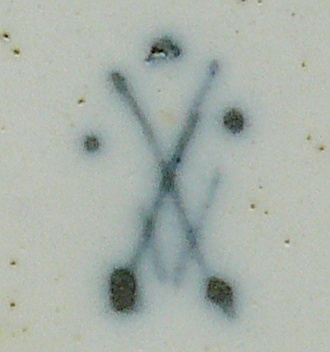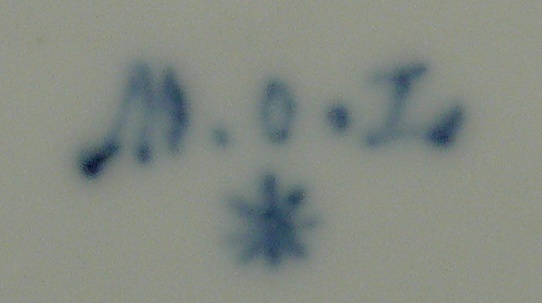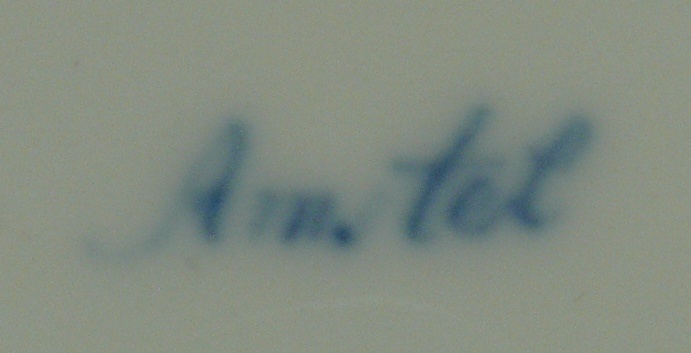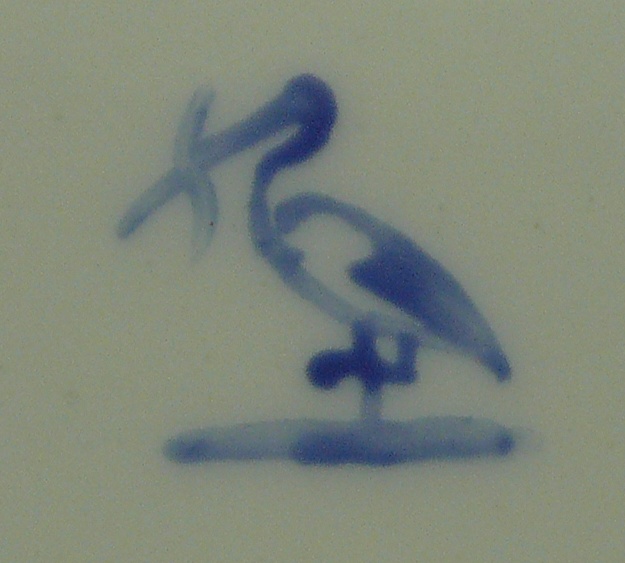History Dutch Porcelain
WE ARE VERY INTERESTED IN BUYING DUTCH PORCELAIN !!!
The birthplace of porcelain is China, where early in the 8th century a high quality product was succesfully produced which, after firing, the material seemed to be translucent.
Even more important was that this product, even in an unglazed state, was not porous ( moisture does not penetrate the material ).
This as opposed to pottery, which is porous and must be glazed to avoid penetration of liquids. ( An unglazed pottery flower pot placed on a table will always leave moisture rings ).
Although the existence of Chinese porcelain was known at an early stage in Europe, largescale distribution only came about through the activities of the V.O.C. ( Dutch East India Company ).
Appreciation for this unique product and the enormous collecting mania of, amongst others prominent Nobility, stimulated people in Europe to search diligently for the secret of the porcelain manufacture.
Even so, it was to take until 1708 before Joachim Böttger in Meissen first succeeded in producing porcelain.
August the Strong, elector of Saxony, - who actually commissioned Böttger to make gold, tried for a long time to keep the recipe for porcelain manufacture a secret, but eventually failed.
New porcelain factories sprang up all over Europe, and in Holland too!
The history of Dutch porcelain begins in Weesp.
WEESP PORCELAIN 1759 - 1770
After a short preliminary period Earl of Gronsveld-Diepenbroick-Impel was succesful in mastering the manufacture of porcelain. The core of the factory in Weesp was formed by experienced porcelain workers who were “bought” from the German and French workshops.
One of them was the Frenchman Louis Victor Gerverot, who as painter and model maker was to fill an important function in the Weesp factory.
The products of the Weesp factory were mostly carried out in the then popular Rococo style, with much relief work and very elegant decoration. Surprising is that there is no decoration found in the so-called under glaze blue, whilst this blue was used for the mark.
Unfortunately, it was not long before it became apparent that the Weesp porcelain factory could not compete with the foreign competition.
This led to its bankruptcy in 1770 after which time it ceased to exist.
Porcelain made in the Weesp factory was marked with two crossed swords with three balls in between.
The swords and the balls came from the family crests of the Earl and his wife.
The porcelain made in the Weesp factory is, without doubt, the most rare of all Dutch porcelain. Mark Weesp porcelain
Mark Weesp porcelain
+++++++++++++++++++++++++++++++++++++++++++++++++++++
OUDE LOOSDRECHT PORCELAIN 1774- 1784
Vicar de Mol of Oude-Loosdrecht, was busy for some time with research into the secret of the porcelain manufacture.
This research was partly born of personal interest and partly of social concern.
There was much unemployment and poverty in his parish, to which he endeavoured to put an end.
When his experiment – with the help of Gerverot, already mentioned in Weesp - appeared to be successful, he decided to set up his own porcelain factory. In order to fight the unemployment as effectively as possible, with the help of a small group of (experienced ) foreign workers, as many as possible local workers were trained to make porcelain.
For this period in the porcelain manufacture, the Loosdrecht factory supplied a large production and an enormous variety of articles. As far as decoration was concerned, landscapes took a prominent place.
Vicar de Mol came up against the same problems as his predecessor in Weesp. These were the high production costs, fierce foreign competition and a too small market. The previously mentioned large variation in articles appeared, in the long run, not to be to his advantage.
Vicar de Mol died in1782 in great poverty, after which the factory was carried on by a number of money lenders. The money lenders also had no succes however in making the factory profitable which resulted in its definite closing in 1784.
Loosdrecht porcelain was marked with the letters M.O.L. ( except for a very short early period when a standing lion was used as mark ).
The letter combination M.O.L. can be interpreted in two ways: the chosen letters spelled the vicar’s own name and also stood for the abbreviation of Manufacture Oude-Loosdrecht.
With a few exceptions, the mark was carried out in underglaze blue and the letters M.O.L. were also often engraved in the still wet clay.

++++++++++++++++++++++++++++++++++++++++++++++++++++++++
AMSTEL PORCELAIN 1784-1809 / 1809-1814
The closing of Vicar de Mol’s factory did not, however, mean the end of the porcelain production in Holland.
Seeing as a number of financiers had put large amounts of money in the Loosdrecht factory, they sought ways of securing their invested capital. They thought they had found the solution by transfering the Loosdrecht factory to a - from an economic viewpoint – better location in Ouder-Amstel.
Many of the employees moved with the factory taking all equipment, moulds and remaining stock with them.This would explain why articles manufactured during the early period of the Amstel factory show similarities with Vicar de Mol’s production.
The products from the Amstel factory were marked with the word Amstel in underglaze blue.
Sometimes Amstel products bear the Loosdrecht mark ( in underglaze blue ) as well as the Amstel mark. This could be part of the stock already marked in Loosdrecht when taken over by Amstel.
On the other hand, seeing the ( sometimes ) illogical place of the M.O.L. mark, it would seem more realistic to assume that in the early days, the Amstel factory used the Loosdrecht mark, possibly because this had already attained a reputable name.
Amstel products soon began to show their own characteristics, directly related to the style of Louis XVI period.
In 1800 the factory was taken over by the Dommer family, but the name of Amstel was still used.
++++++++++++++++++++++
In 1809 the factory was moved to Nieuwer Amstel.
Presumably, during this last period of the Amstel factory ( until 1814), no more porcelain was produced. The activities were limited to decorating porcelain from other factories, mostly from Paris or Brussels.
Typical Empire shapes appear during this period.
The porcelain from this last period is not marked Amstel in underglaze blue any more, but Amstel in different colours over glaze ( amongst others red, black and gold ).
The factory was closed in 1814 and this was also the end of the Dutch porcelain production.
++++++++++++++++++++++++++++++++++++++++++++++++++++++++
THE HAGUE PORCELAIN 1776-1790
The Hague porcelain factory, founded by Anton Lijncker, has its own story within the history of Dutch porcelain.
From 1772 Anton Lijncker’s son had a shop in The Hague in which, apart from textile, mostly porcelain was sold. Before Anton Lijncker ( from Dresden ) could undertake business activities in The Hague, he had to obtain Citizenship of this city, which was granted to him in 1776.
He immediately made known that he wished to start a porcelain factory in The Hague. He found support for his resolve in the very positive attitude of Governor William V, the Dutch Nobility and The Hague’s City Council.
Anton Lijncker gave the impression that the porcelain was made in his factory from scratch. Although for some time this was assumed to be true, it is now believed that this was not the case and that the Hague factory only decorated porcelain. This porcelain was bought-in in undecorated state, from foreign factories, mainly Ansbach (Germany) and Doornik (Belgium).
Although Anton Lijncker’s approach was totally different from that of Weesp, Loosdrecht and Amstel, his enterprise was also not granted a long existence.
The Hague factory was closed in 1790.
++++++++++++++++++++++++++++++++++++++++++++++++++++++++
GEVRAAGD :
HOLLANDS ZILVER
+++++++++++++++++
BLOEDKORAAL
+++++++++++++++++
HOLLANDS
PORSELEIN:
WEESP
LOOSDRECHT
AMSTEL
HAAGS
